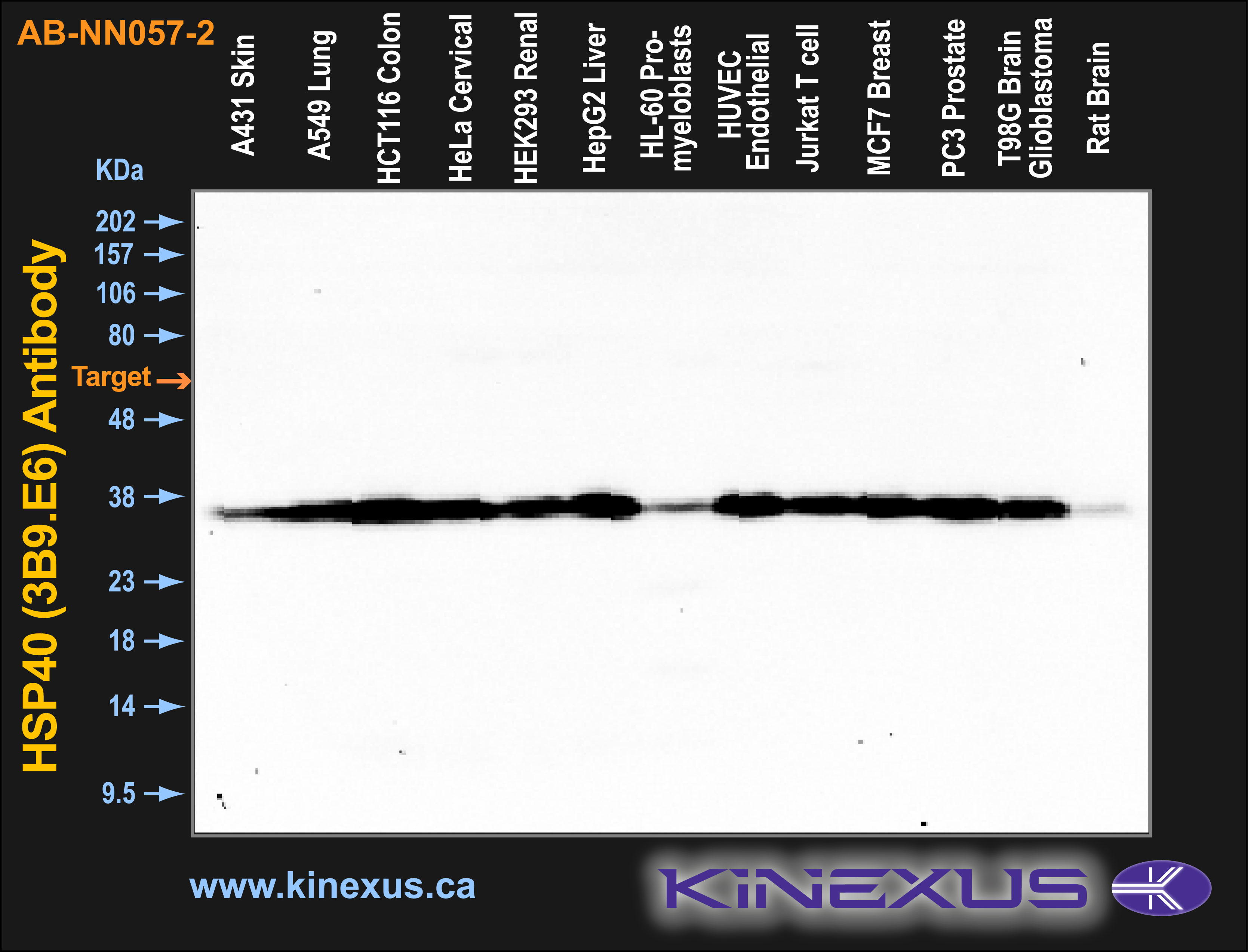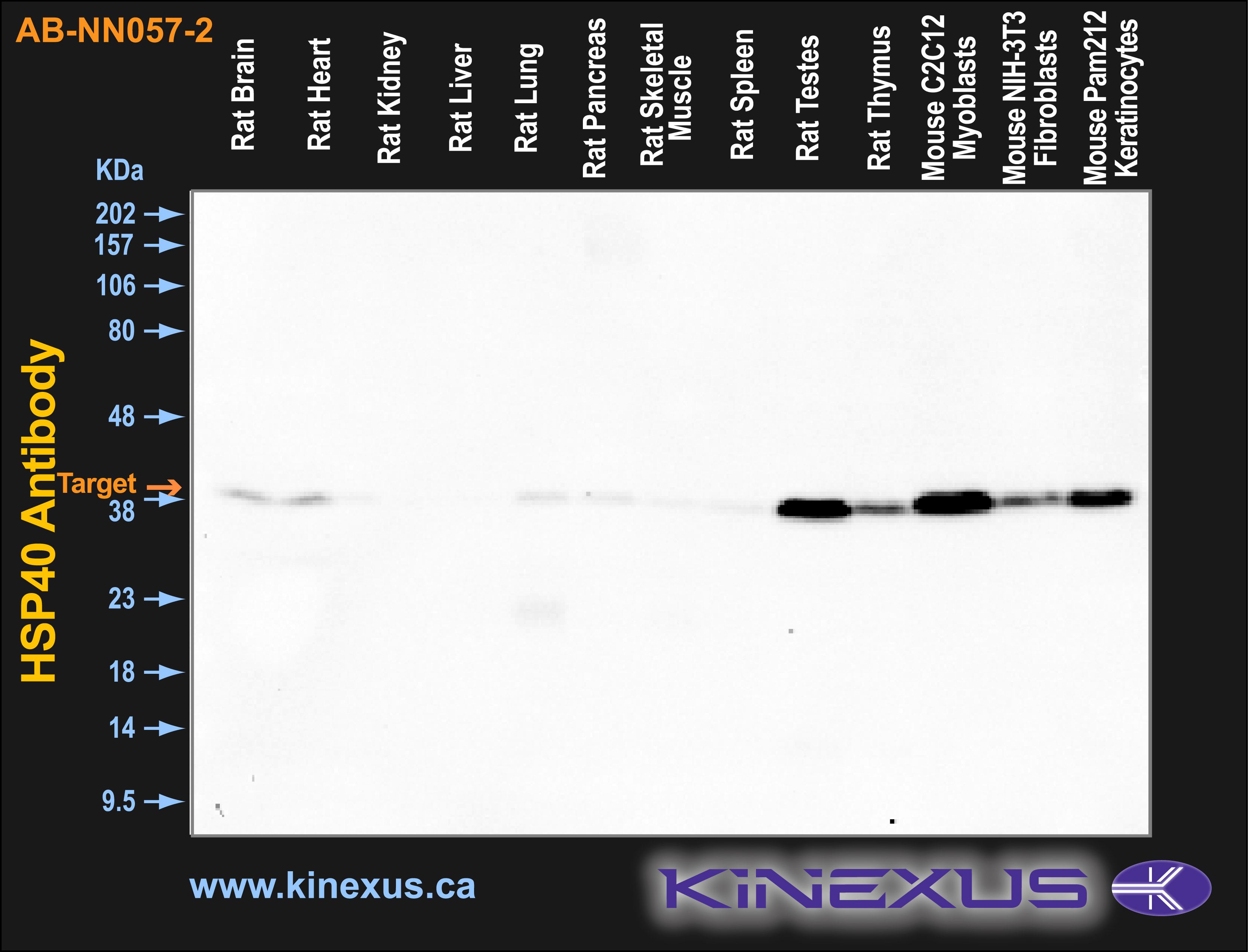Product Name: HSP40, Hdj1
Product Number: AB-NN057-2
| Size: | 25 µg | Price: | 89.00 | |
| $US |
Target Full Name: DnaJ homolog subfamily B member 1
Target Alias: DNAJ1; NDAJB1; HDJ1; HSP40; HSPF1; DnaJ homologue subfamily B member 1; Dna J protein homologue 1; Heat shock 40 kDa protein 1; HSP40; heat shock protein 40; Human DnaJ protein 1; hDj-1
Product Type Specific: Heat shock/stress protein pan-specific antibody
Antibody Code: NN057-2
Antibody Target Type: Pan-specific
Protein UniProt: P25685
Protein SigNET: P25685
Antibody Type: Monoclonal
Antibody Host Species: Mouse
Antibody Ig Isotype Clone: IgG1
Target Alias: DNAJ1; NDAJB1; HDJ1; HSP40; HSPF1; DnaJ homologue subfamily B member 1; Dna J protein homologue 1; Heat shock 40 kDa protein 1; HSP40; heat shock protein 40; Human DnaJ protein 1; hDj-1
Product Type Specific: Heat shock/stress protein pan-specific antibody
Antibody Code: NN057-2
Antibody Target Type: Pan-specific
Protein UniProt: P25685
Protein SigNET: P25685
Antibody Type: Monoclonal
Antibody Host Species: Mouse
Antibody Ig Isotype Clone: IgG1
Antibody Immunogen Source: Recombinant protein HSP40 (Hdj1)
Production Method: Protein G purified
Antibody Modification: Unconjugated. Contact KInexus if you are interest in having the antibody biotinylated or coupled with fluorescent dyes.
Antibody Concentration: 1 mg/ml
Storage Buffer: Phosphate buffered saline pH7.2, 50% glycerol, 0.09% sodium azide
Storage Conditions: For long term storage, keep frozen at -40°C or lower. Stock solution can be kept at +4°C for more than 3 months. Avoid repeated freeze-thaw cycles.
Product Use: Western blotting | Immunohistochemistry | ICC/Immunofluorescence | Immunoprecipitation | ELISA
Production Method: Protein G purified
Antibody Modification: Unconjugated. Contact KInexus if you are interest in having the antibody biotinylated or coupled with fluorescent dyes.
Antibody Concentration: 1 mg/ml
Storage Buffer: Phosphate buffered saline pH7.2, 50% glycerol, 0.09% sodium azide
Storage Conditions: For long term storage, keep frozen at -40°C or lower. Stock solution can be kept at +4°C for more than 3 months. Avoid repeated freeze-thaw cycles.
Product Use: Western blotting | Immunohistochemistry | ICC/Immunofluorescence | Immunoprecipitation | ELISA
Antibody Dilution Recommended: WB (1:2000), ICC/IF (1:100); optimal dilutions for assays should be determined by the user.
Antibody Potency: High potency. Detects a ~40 kDa protein in cell and tissue lysates by Western blotting.
Antibody Species Reactivity: Human | Mouse | Rat
Antibody Positive Control: 0.5 µg/ml of SMC-145 was sufficient for detection of HSP40 (HDJ1) in 15 µg of HeLa cell lysate by colorimetric immunoblot analysis using Goat anti-mouse IgG:HRP as the secondary antibody.
Antibody Specificity: Very high
Antibody Cross Reactivity: Does not cross-react with HDJ2 or YDJ1.
Related Product 1: HSP40 pan-specific antibody (Cat. No.: AB-NN057-3)
Antibody Potency: High potency. Detects a ~40 kDa protein in cell and tissue lysates by Western blotting.
Antibody Species Reactivity: Human | Mouse | Rat
Antibody Positive Control: 0.5 µg/ml of SMC-145 was sufficient for detection of HSP40 (HDJ1) in 15 µg of HeLa cell lysate by colorimetric immunoblot analysis using Goat anti-mouse IgG:HRP as the secondary antibody.
Antibody Specificity: Very high
Antibody Cross Reactivity: Does not cross-react with HDJ2 or YDJ1.
Related Product 1: HSP40 pan-specific antibody (Cat. No.: AB-NN057-3)
Related Product 2: HSP40 pan-specific antibody (Cat. No.: AB-NN057-4)
Related Product 3: HSP40, YDJ1 pan-specific antibody (Cat. No.: AB-NN057-5)
Related Product 4: HSP40, YDJ1 pan-specific antibody (Cat. No.: AB-NN057-6)
Related Product 3: HSP40, YDJ1 pan-specific antibody (Cat. No.: AB-NN057-5)
Related Product 4: HSP40, YDJ1 pan-specific antibody (Cat. No.: AB-NN057-6)
Scientific Background: Human HSP40/DnaJ proteins comprise a large protein family, members of which feature the J domain (named after the bacterial DnaJ protein) (1). The J-domain spans the first 75 N-terminal amino acids and is separated from the C-terminal by a glycine/phenylalanine-rich domain (2). Members of the HSP40/DnaJ family play diverse roles in many cellular processes, such as folding, translocation, degradation and assembly of multi-protein complexes. In particular, Hdj1, the first human HSP40/DnaJ protein identified, plays an important role in protein translation and folding, as well as in the regulation of HSP70 function (3). HSP40 stimulates the ATPase activity of HSP70 which in turn causes conformational changes of the unfolded proteins (4, 5). The HSP40-HSP70-unfolded protein complex further binds to co-chaperones Hip, Hop and HSP90 which leads to protein folding, or components of protein degradation machinery CHIP and BAG-1 (6). Some studies have shown that the difference between HDJ1 and type 1 DNAJ proteins including HDJ2 and yeast YdjI is the result of the possession of a zinc finger domain by the latter, which helps in the function of protein folding. (7, 8).
Figure 1. Immunoblotting of various cell lines with AB-NN057-3 antibody at a 1000 X dilution. The target protein Hsp40 is indicated. Each lane was loaded with 15 µg of cell lysate protein. The max signal count was 8722.
Figure 2. Immunoblotting of various tissue lines with AB-NN057-3 antibody at a 1000 X dilution. The target protein Hsp40 is indicated. Each lane was loaded with 15 µg of tissue lysate protein. The max signal count was 9885.
References
[1] Cheetham M.E. and Caplan A.J. (1998) Cell Stress Chaperones 3: 28–36.
[2] Fan C.Y. et al. (2003) Cell Stress Chaperones 8: 309–316.
[3] Sohn S.Y., Kim S.B., Kim J., and Ahn B.Y. (2006) J Gen Virol. 87(7): 1883-91.
[4] Liberek K. et al. (1991) Proc. Natl. Acad. Sci. USA 88: 2874–2878.
[5] Cyr D.M. et al. (1992) J Biol Chem. 267: 20927–20931.
[6] Höhfeld J. et al. (2001) EMBO Rep. 2: 885–890.
[7] Terda K. et al. (1997) J Cell Biol. 139: 1089-1095.
[8] Lu Z. and Cyr D.M. (1998) J Biol Chem. 273: 27824-27830.
[1] Cheetham M.E. and Caplan A.J. (1998) Cell Stress Chaperones 3: 28–36.
[2] Fan C.Y. et al. (2003) Cell Stress Chaperones 8: 309–316.
[3] Sohn S.Y., Kim S.B., Kim J., and Ahn B.Y. (2006) J Gen Virol. 87(7): 1883-91.
[4] Liberek K. et al. (1991) Proc. Natl. Acad. Sci. USA 88: 2874–2878.
[5] Cyr D.M. et al. (1992) J Biol Chem. 267: 20927–20931.
[6] Höhfeld J. et al. (2001) EMBO Rep. 2: 885–890.
[7] Terda K. et al. (1997) J Cell Biol. 139: 1089-1095.
[8] Lu Z. and Cyr D.M. (1998) J Biol Chem. 273: 27824-27830.
© Kinexus Bioinformatics Corporation 2017



